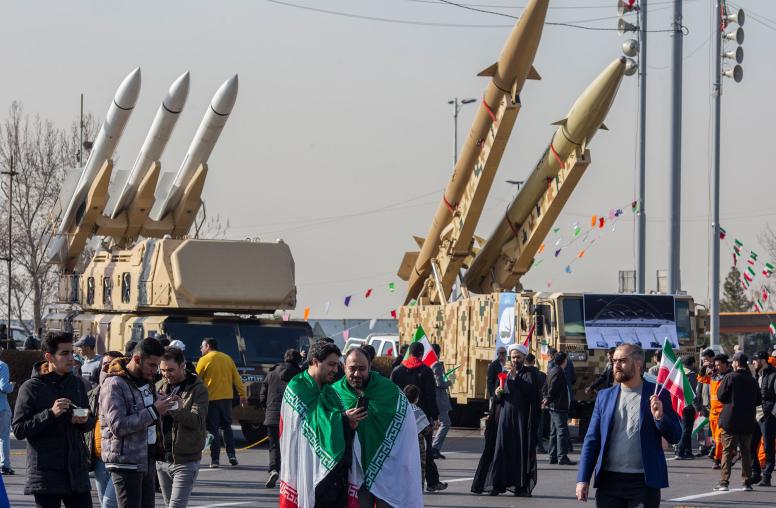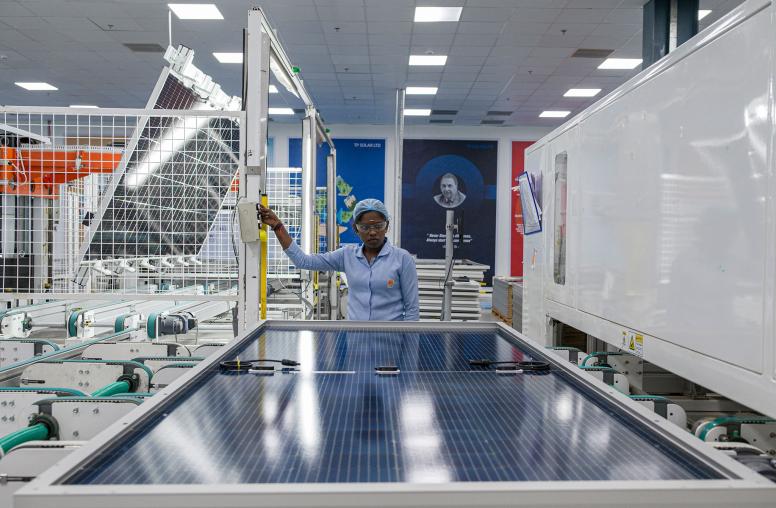Tensions over Taiwan Rise with Tsai’s U.S. Stopover
But Washington can still help avert crisis or conflict in the Taiwan Strait. Here are five ways.
President Tsai Ing-wen of Taiwan transits this week through the United States, stopping in New York on her way to Guatemala and Belize, and in California on her way home. Tsai has made six stopovers since she took office in 2016, but this is the first since July 2019. The stopovers are not official visits, but Tsai is expected to meet Speaker of the House Kevin McCarthy in California. Beijing has made it known it fiercely opposes the stopover and threatened to retaliate if McCarthy and Tsai meet. The trip comes against the backdrop of strengthening ties between Washington and Taipei, China’s increased hostility toward both the United States and Taiwan and the run-up to Taiwan’s 2024 presidential election.

Reviewing this backdrop demonstrates just how much Taiwan remains a central sticking point in the U.S.-China relationship. Nonetheless, there are important steps Washington can take to avert crisis in the Taiwan Strait.
Taipei and Washington Continue to Reinforce Ties
The last two months have featured a steady drumbeat of activity between Washington and Taipei. These engagements fall within the mandate provided by the 1979 Taiwan Relations Act to continue strong U.S.-Taiwan relations and provide the means necessary for Taiwan to maintain a sufficient self-defense capability. Unsurprisingly, this has elicited a strong reaction from Beijing.
Tsai’s visit to the United States follows other notable travel over the past few months. In February, Representative Mike Gallagher, chair of the newly established House Select Committee on the Chinese Communist Party, and Deputy Assistant Secretary of Defense for China Michael Chase both separately visited Taiwan. Also in February, senior officials from the United States and Taiwan met discretely in Washington for security talks. These “special channel” meetings have been taking place for years but usually are not reported in the press or discussed publicly.
As expected, Beijing’s rhetorical response to these meetings was strong. On Chase’s visit, China’s Taiwan Affairs Office spokesperson, Zhu Fenglian, stated that China “resolutely opposes any official interaction and military collaboration” between the United States and Taiwan. She went on to say that any effort by Tsai’s Democratic Progressive Party (DPP) to move toward independence would “bring disaster to Taiwan compatriots.”
Other forms of regular connectivity have also continued to increase: U.S. congressional delegations regularly visit the island and meet with Taiwanese policymakers; March 2 saw the approval of a potential $619 million sale to Taiwan of arms and equipment; and news broke that the United States has quadrupled its number of deployed troops on Taiwan over the past year.
China Increases Hostile Rhetoric and Continues Military Intimidation
Since then-Speaker Nancy Pelosi visited Taiwan in August 2022, Beijing has subjected the island to repeated acts of intimidation, including unprecedented intrusions into airspace and offshore waters in numbers and proximity to the island of Chinese military aircraft and naval vessels. In 2022, China sent 1,727 planes into Taiwan’s air defense identification zone (ADIZ), up from 960 incursions in 2021 and 380 in 2020. Although intensity has decreased since August, these activities have become a “new normal” and bring Taiwanese and Chinese crafts into closer proximity on a more regular basis, increasing the risk of accidents or collisions.
China has also ramped up its rhetorical attacks on Washington. In recent months, the highest ranks of the Chinese Community Party’s leadership have returned to strong “wolf warrior” language toward the United States and its actions toward Taiwan. Chinese leader Xi Jinping took direct aim at the United States during his remarks at recent legislative meetings, stating: “Western countries, led by the United States, are implementing all-round containment, encirclement and suppression against us.”
Further, at the same event Qin Gang, China’s new foreign minister and former ambassador to the United States, brought forward harsh rhetoric on the United States and Taiwan, warning that “mishandling of the Taiwan question will shake the very foundation of China-U.S. relations.” He continued, “If the United States truly expects a peaceful Taiwan Strait, it should stop containing China by exploiting the Taiwan question, return to the fundamental of the one-China principle, honor its political commitment to China, and unequivocally oppose and forestall Taiwan independence.” Similar rhetoric was employed by Wang Yi, China’s top diplomat, at the Munich Security Conference, stalling meetings between him and Secretary of State Antony Blinken.
This signals a U-turn from a more conciliatory tone in Chinese rhetoric toward the United States in the lead-up to Blinken’s postponed trip to China, before the “balloon incident” stalled those talks. At the time of this writing, there is still no date scheduled for a call between Biden and Xi nor a Blinken visit, and it is unclear how productive such a call will be in the current state of bilateral relations.
Relationship with China is on the Ballot for Taiwan’s Presidential Elections
As Taiwan’s 2024 presidential election season begins to heat up, it is clear that Taipei’s relationship with Beijing will be a primary issue at the ballot box. The Kuomintang party, or KMT, enjoyed a sweeping victory in local elections last fall, where campaigns focused primarily on kitchen-table issues, but questions of cross-Strait relations will play a larger role in the presidential election. As the campaign season begins, the travel itineraries of each party’s notable figures, past and present, sheds light on their preferences for how to manage the relationship with Beijing.
As Tsai transits through the United States, former president Ma Ying-Jeou of the KMT is in China for a 10-day visit, a historic first for a former president of Taiwan. Moreover, current KMT vice chairman Andrew Hsia has made at least two visits to China since August. Although the KMT recognizes that voters increasingly identify as “Taiwanese” and do not want to unify with China, party leaders say that by maintaining open communication channels with Beijing they will be better able to manage cross-Strait relations.
At the same time, they argue that Tsai and her administration have been provocative and dangerous in their dealings with Beijing: party slogans warn that voting for the DPP will send Taiwanese youth to the battlefield. Other criticisms blame Tsai for losing diplomatic allies; Taiwan had formal diplomatic ties with 22 states when her term began and now only 13 remain following Beijing’s all-out campaign to lure away Taiwan’s remaining diplomatic allies. The most recent loss came earlier this month when Honduras switched recognition to China.
For her part, Tsai has walked a fine line in her efforts to continue to strengthen ties with Washington and avoid deliberately provoking Beijing. She announced a decision to increase military conscription from four months to one year, a move that is popular with the general public, but reportedly discouraged McCarthy from visiting Taipei early in the year in an effort to avoid a retaliation from Beijing. Although Tsai is not eligible to run for another term, her vice president, Lai Ching-te, has declared his candidacy for the top job. Lai’s cross-Strait position has emphasized that he would not advocate for Taiwanese independence, but rather seek to defend the de-facto independence Taiwan already enjoys. However, any DPP candidate will be seen as inherently threatening by Beijing.
How Can the United States Help Avert Crisis or Conflict in the Taiwan Strait?
Amid strained U.S.-China relations, Taiwan remains a prolonged point of tension, and at worst, a potential flashpoint. Taiwan’s 2024 elections could add yet another point of friction. Washington should closely monitor the situation and can help prevent escalation over and in the Taiwan Strait. In this effort, the United States should:
- Work with allies, partners and friends to raise the diplomatic, military and economic costs for Beijing of a potential conflict. The impacts of a conflict over Taiwan would not be limited to the Indo-Pacific and would have global implications.
- Continue to help Taiwan improve its self-defense capability and island-wide resiliency, and provide regular reassurances to Taipei, Beijing and regional allies that it does not seek war.
- Encourage Taipei and Beijing to improve communication channels to preserve the status quo and avoid miscalculation that could potentially lead to conflict in the Taiwan Strait. For example, U.S. officials are reportedly in contact with Chinese officials to “to remind them of past precedents regarding U.S. Transits of Taiwanese presidents.” This is no guarantee that Beijing will not respond sharply to Tsai’s stopover, but could help avoid miscalculation and misreading of signals.
- Ensure that its own channels of communication with China remain open and robust, so that the two sides can be candid about their differences and reduce the risk of conflict. Yet Washington should hold these discussions on its own terms and should not sacrifice its principles and other national security interests just to keep those communication lines open.
- Avoid the perception that Washington is “loving Taiwan to death,” a phrase coined by China expert Richard Bush. As the U.S.-China bilateral relationship has continued to spiral downward, Taiwan has become a useful symbol for both sides to express displeasure at the other’s behavior. In providing aid and support for Taiwan, U.S. policymakers must be careful that they are not inadvertently creating a riskier situation for its people.



